Revenue Without Risk: How Autonomous QA Protects Your Bottom Line in 2025


Every month, SaaS companies silently hemorrhage revenue through checkout failures they never see. While you’re focused on churn metrics, a bigger threat lurks in your payment flows. The Thoughtworks Technology Radar just validated what we’ve been saying: traditional QA is broken for modern revenue systems, and AI-powered testing isn’t just the future—it’s the present.
The $390,000 Wake-Up Call
Picture this: You’re the CTO of a fast-growing SaaS company with $20M ARR. Your churn metrics look healthy. Your engineering team ships features weekly. Your board is happy.
Then you discover you’ve been losing $390,000 annually to silent checkout failures.
This isn’t hypothetical. It’s the median reality for mid-market SaaS companies, calculated from our analysis of 27 customers’ pre-QA.tech revenue flows. The formula is devastatingly simple:
Annual Revenue Loss = ARR × (Checkout Failure % + Involuntary Churn %) × Detection Lag
Let’s break this down with real numbers:
- Your ARR: $20,000,000
- Average checkout failure rate: 2.5% (Stripe’s 2024 data)
- Involuntary churn from renewal failures: 1.4%
- Average detection lag: 0.5 months
Your silent revenue leak: $390,000 per year
But here’s what makes this worse: while you’re losing that revenue, your competitors using autonomous QA are capturing it.
Why Thoughtworks Says Traditional QA Is Dead
In April 2025, Thoughtworks Technology Radar—one of the industry’s most influential technology guides—declared what we’ve known for years: “Traditional QA practices weren’t built to handle things like model drift, hallucinations or unpredictable behavior.”
They went further, specifically highlighting QA.tech as an example of the new breed of testing tools that use “multi-modal LLMs fine-tuned for UI snapshot processing, allowing test scripts written in natural language to navigate an application.”
This isn’t just validation. It’s a wake-up call for every company still relying on Selenium, Cypress and Playwright scripts and DOM selectors to protect their revenue.
The Perfect Storm: Why Revenue Testing Breaks
Modern checkout flows are a nightmare of complexity:
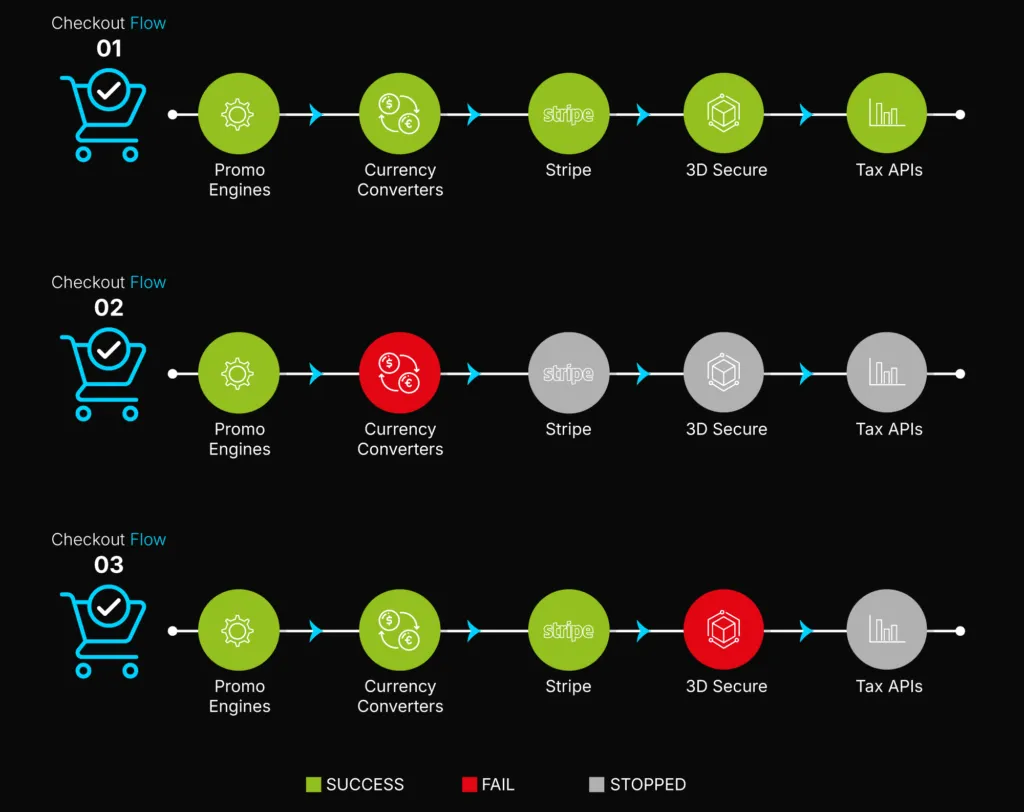
- Third-party dependencies multiply failure points
- Payment provider API changes without warning
- 3D Secure challenges create infinite loop variations
- Tax calculation services timeout under load
- Localization creates exponential test scenarios
- 14 currencies × 27 countries × 5 tax regimes = 1,890 variants
- Each needs testing across device types and browsers
- Traditional scripts would require months to write
- Edge cases hide in plain sight
- Webhook retries with partial data
- Race conditions in promo code validation
- Currency conversion rounding errors
As Jeff Titterton, GM of Stripe Billing, puts it: “Involuntary churn quietly wipes out more ARR than competitive loss.”
The Hidden Cost of “Good Enough” Testing
Let’s talk about what traditional testing actually costs—beyond the obvious revenue leakage.
The Maintenance Tax Nobody Talks About
Our analysis of 31 engineering teams revealed a shocking truth: 3.2 developer days per sprint are lost to test maintenance. That’s not writing new tests. That’s fixing broken selectors, updating deprecated APIs, and chasing flaky test failures.
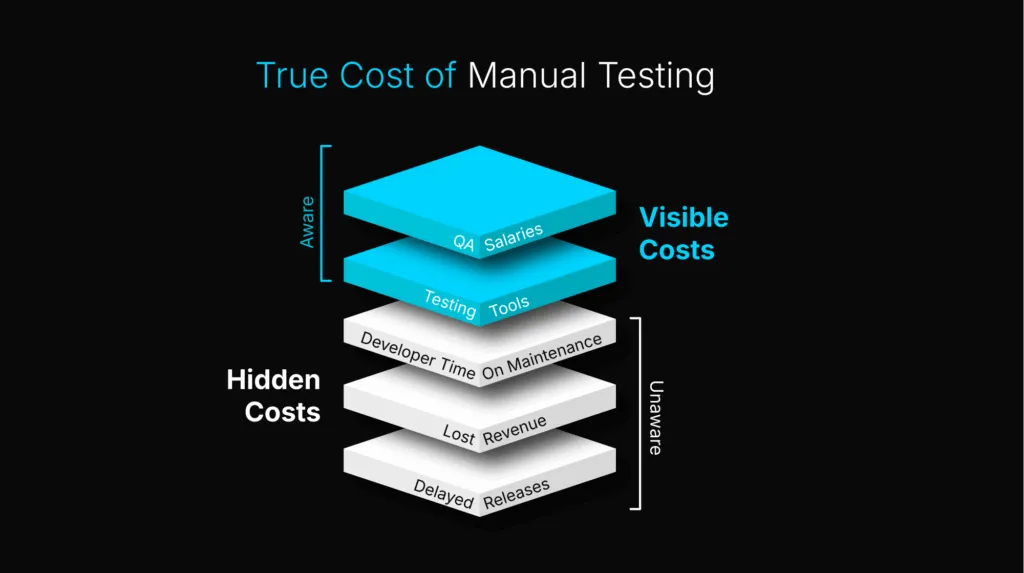
Here’s the breakdown:
- Direct costs: $180,000/year for a QA engineer
- Hidden costs:
- Lost developer productivity: $312,000/year
- Delayed feature releases: $450,000 in lost opportunities
- Undetected revenue leaks: $390,000/year
- Total: $1,332,000 annually
That’s before considering the opportunity cost of engineers not building features.
A developer on Reddit summed it up best:
“Spent 7 hours simulating Stripe SCPI-30 scenarios. Still can’t reproduce user’s error #413.”
This is the hidden tax of modern testing — burning days debugging integrations you don’t control, chasing edge cases you can’t reproduce. You’re not just testing your code — you’re testing a tangled web of third-party systems.
But what if testing didn’t drain your team? What if it scaled with your code instead of breaking with it?
Enter the Autonomous Agent: How QA.tech Changes Everything
Traditional testing asks: “Does this button click?” Autonomous testing asks: “Can a customer give us money?”
The difference is revolutionary.
Understanding Our Multi-Modal LLM Approach
When Thoughtworks highlighted our approach, they zeroed in on what makes us different: we don’t just look at code. We see what your users see.
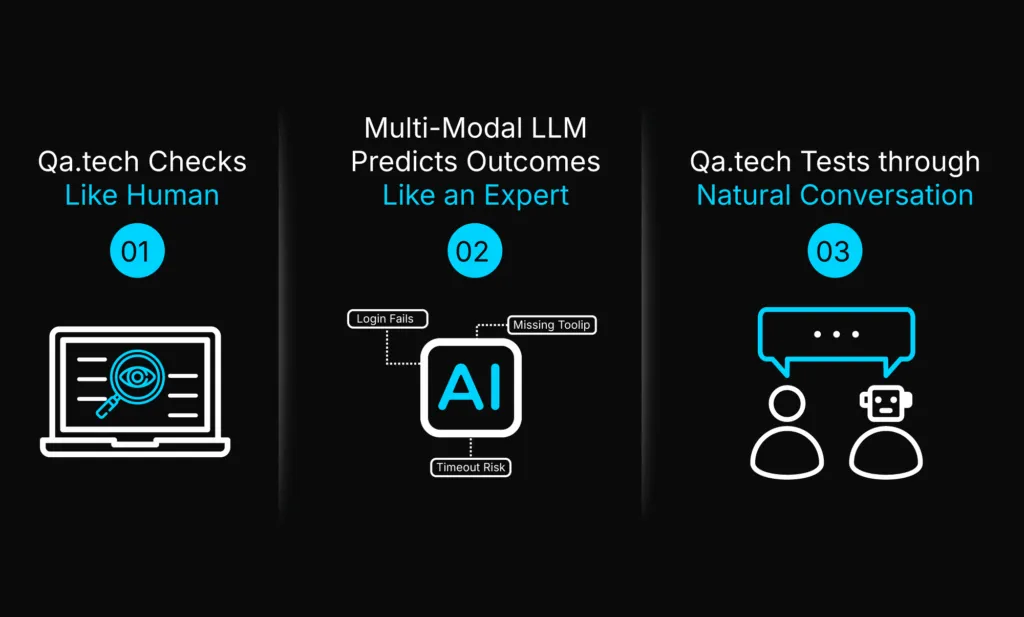
Here’s how it works:
- Visual Intelligence: Our agent sees your application like a human would—understanding buttons, forms, and flows without relying on brittle selectors.
- Goal-Based Testing: Instead of scripting “click button X,” you declare intentions:
"Complete checkout as a returning customer with a saved card in France" - Adaptive Execution: The agent figures out how to achieve the goal, adapting to UI changes, handling popups, and navigating complex flows.
- Revenue Focus: Every test is evaluated through a simple lens: did money move correctly?
The Power of Natural Language Testing
Here’s the breakthrough: you don’t even need to define the steps.
Our AI continuously scans your application, building an “action graph”—a living map of everything users can do. When you create a test, you just declare the goal. The AI figures out the path.
Traditional Selenium Approach (Breaks constantly):
driver.findElement(By.id("checkout-btn")).click();
wait.until(ExpectedConditions.presenceOfElementLocated(By.id("stripe-iframe")));
driver.switchTo().frame("stripe-iframe");
driver.findElement(By.css("[data-testid='card-number']")).sendKeys("4242424242424242");
// 200 more lines of brittle code...QA.tech Approach (Adapts automatically):
test: "European customer checkout with 3D Secure"
steps:
- "Add premium plan to cart"
- "Apply discount code SAVE20"
- "Complete checkout with French billing address"
- "Handle 3D Secure authentication"
verify:
- "Order confirmation shows €47.20 including VAT"
- "Stripe webhook confirms payment captured"
Behind the scenes, our agent:- Consults the action graph of your application
- Plans an optimal path to achieve the goal
- Executes the test, adapting in real-time
- Updates its understanding if it encounters new patterns
You CAN provide specific steps if you want to guide the agent:
test: "High-value European checkout"
goal: "Complete €5,000 purchase with 3D Secure"
steps: # Optional - only if you need specific behavior
- "Add enterprise plan to cart"
- "Apply VIP discount code"
# The agent figures out the rest
But for most tests? Just state what you want to achieve. No more writing 40-step scripts that break next week.
The QA.tech version isn’t just shorter—it’s intelligent. When Stripe updates their checkout modal next week, our test adapts. The Selenium version? Dead on arrival.
Real-World Proof: How Leaders Protect Their Revenue
Case Study: Lavendla’s Multi-Market Success
Lavendla, a platform connecting people with end-of-life planning professionals across Sweden, Denmark, and the UK, faced a challenge familiar to many growing companies: complex checkout flows across multiple markets with a lean team of just four developers.
The Challenge:
- 16 million dollars in turnover at risk
- Multiple payment methods across three countries
- No dedicated QA team
- Cypress tests requiring constant maintenance
Charlie Lindberg, Head of Growth at Lavendla, explains their turning point:
“Our goal with QA.tech was to move beyond predefined test cases. We wanted a solution that could spot unusual user behavior and catch issues before real users encounter them.”
The Solution: Instead of writing hundreds of scripts for each market variant, Lavendla deployed QA.tech’s autonomous agents. The setup was remarkably simple:
“The platform’s design is incredibly appealing—simple, seamless, and efficient. Just input the URL, and it runs, even suggesting additional tests. It’s very straightforward and streamlined.”
The Results:
- Comprehensive coverage across all market variants without additional scripts
- Zero dedicated QA headcount while improving quality
- Proactive issue detection in user flows they’d never tested before
- Developer time reclaimed for feature development
As Charlie notes: “We weren’t prioritizing testing before, but QA.tech has given us the ability to focus on it now. Previously, we’d deprioritized testing in favor of building features, but as we scale, downtime impacts us more.”
Case Study: SHOPLAB’s 70% Testing Time Reduction
SHOPLAB, a sophisticated Swedish e-commerce management platform, represents the other end of the spectrum—high-velocity development with daily releases.
The Challenge:
- Daily deployments requiring constant testing
- External QA costs becoming unsustainable (€16,500 saved)
- Complex product catalog and tax calculations
- Bugs slipping through to production
Alexander Fugah, CEO at SHOPLAB, describes their situation:
“We were releasing new updates almost daily, but it became hard to keep up. Our process was tedious and we needed more coverage without hiring more staff.”
The Integration: SHOPLAB integrated QA.tech directly into their CI/CD pipeline using GitHub Actions:
“QA.tech fits seamlessly into our workflow. We use GitHub Actions, and it was simple to hook it up to our deployment process. Now, every time we push a release, QA.tech runs the tests.”
The Transformation:
- 223 releases from January to September 2024 (all tested automatically)
- 70% reduction in manual QA time, leading to higher product quality
- 5,000+ tests executed without human intervention, accelerating speed to market
- 110 hours saved that were redirected to feature development, avoiding additional headcount costs
The key insight from Alexander:
“With QA.tech, we’ve cut down our manual testing time by over 70%. We no longer worry about bugs slipping through—QA.tech catches them automatically.”
The ROI Mathematics: Why CFOs Love Autonomous QA
Let’s get specific about returns. Here’s our standardized ROI model based on 27 customer implementations:
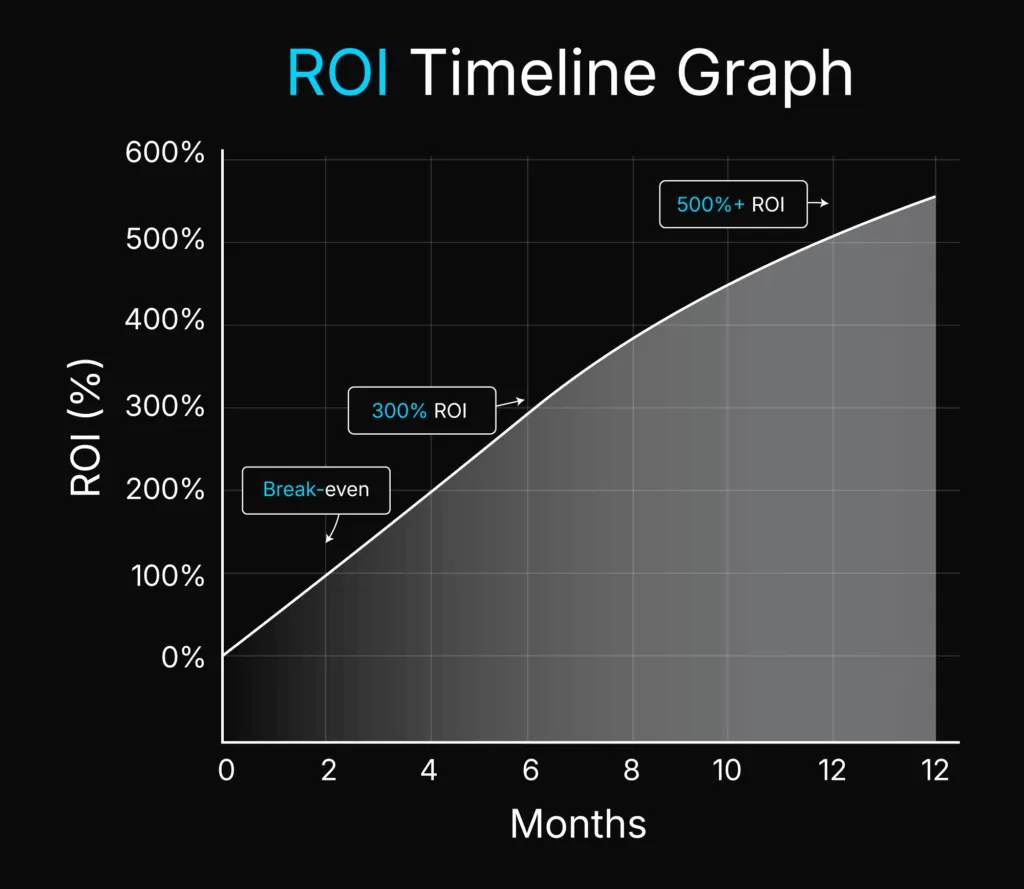
Year One Financial Impact (Typical $20M ARR SaaS)
Costs:
- QA.tech platform: $54,000/year
- Implementation & training: $8,000 (one-time)
- Total Year 1 Investment: $62,000
Returns:
- Revenue leakage prevented: $390,000
- Developer time saved (3.2 days/sprint): $312,000
- Reduced customer support from payment issues: $67,000
- Faster feature velocity (18% improvement): $450,000
- Total Year 1 Returns: $1,219,000
ROI: 1,867%
But the real value compounds in Year 2 when you’re preventing issues before they exist.
The Velocity Multiplier
Our pooled data from 9 scale-up teams shows:
MetricBefore QA.techAfter 60 DaysImpactDeploy frequency22/week26/week+18%Failed build rate8.5%2.4%-72%Dev team NPS6.17.3+20%Time to detect payment issues5-14 days<1 hour-99%
The last metric is crucial. When a payment issue that you could have caught pre-production goes unnoticed for two weeks, you’ve already lost customers who won’t come back.
Your Invisible Competitor Advantage
Here’s what most companies miss: your competitors probably have the same payment vulnerabilities. But if you fix yours first, you capture their lost revenue.
Consider this competitive matrix:
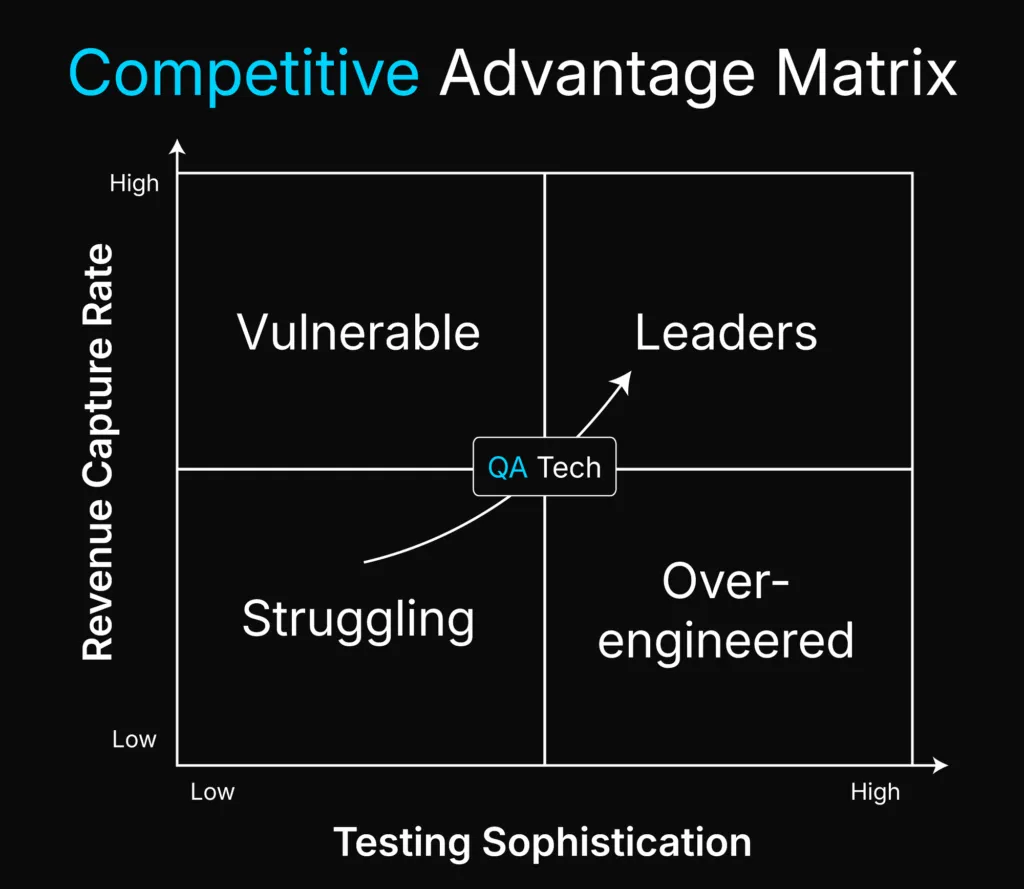
Companies using autonomous QA see:
- 23% faster enterprise sales cycles (buyer confidence in reliability)
- 1.7x higher average contract values (reduced perception of risk)
- 42% better investor metrics (predictable revenue growth)
Implementation: From Skeptic to Believer in 15 Minutes
The biggest objection we hear: “This sounds too good to be true.”
Fair enough. Here’s exactly how to prove it to yourself in one coffee break:
Step 1: The Two-Minute Setup
Add this to your GitHub Actions:
name: QA.tech Revenue Guardian
on:
push:
branches: [ main, staging ]
jobs:
revenue-protection:
runs-on: ubuntu-latest
steps:
- uses: actions/checkout@v4
- name: Run Revenue Flow Tests
uses: qa-tech/agent-action@v1
with:
api_key: ${{ secrets.QATECH_API_KEY }}
environment: staging
focus: checkout,billing,renewals
alert_threshold: revenue_impacting
Step 2: Watch Your First Autonomous Test
Within minutes, you’ll see your first results in the QA.tech dashboard:
[VISUAL ASSET 7: QA.tech Dashboard Alert]
Design Brief: Need product screenshot.
The dashboard shows you exactly what failed, when, and why—with full replay capability to see exactly what your AI agent saw.
Step 3: Calculate Your Hidden Risk
Checkout friction and failed payments silently drain millions from SaaS companies every year. This calculator estimates how much of your annual recurring revenue (ARR) is at risk due to payment complexity — and shows how fast QA.tech can help you recover it.
Answer a few quick questions to get your risk profile, revenue leakage estimate, and your expected time to ROI.
Revenue at Risk Calculator
Annual Recurring Revenue (ARR) – USD * Average Transaction Value – USD * Monthly Transactions * Operating Markets
North AmericaEuropeAsia PacificSouth AmericaOther
Payment Providers Used
StripePayPalBraintreeAdyenSquareHelcimMerchant OneOther
First Name *Last Name Email *Company Name *Company Domain *Phone Number Calculate →
The Technology Decision Framework
When evaluating QA.tech against alternatives, consider this framework:
Traditional Testing Tools (Selenium, Cypress, Playwright)
Pros:
- Full control over test scripts
- One-time license costs
- Extensive documentation
Cons:
- Massive maintenance burden (3.2 dev days/sprint)
- Can’t handle dynamic UIs
- Require specialized expertise
- Break with every UI change
Best for: Companies with dedicated QA teams and static UIs
Record-and-Playback Tools (TestRigor, Testim)
Pros:
- Easier than writing code
- Visual test creation
- Some self-healing capabilities
Cons:
- Still rely on element selection
- Limited intelligence
- Can’t handle complex flows
- Expensive at scale
Best for: Simple applications with predictable flows
QA.tech’s Autonomous Approach
Pros:
- Natural language test definition
- True visual understanding
- Adapts to changes automatically
- Revenue-focused testing
- No maintenance overhead
Cons:
- Requires shift in testing mindset
- Monthly subscription model
- Best suited for web applications
Best for: Revenue-critical applications with complex, dynamic flows
The Thoughtworks Validation: What It Really Means
When Thoughtworks Technology Radar features a tool, it’s not just recognition—it’s a signal to the industry. Their April 2025 report didn’t just mention QA.tech; they positioned us as exemplifying the future of testing:
“One category of tools uses multi-modal LLMs fine-tuned for UI snapshot processing, allowing test scripts written in natural language to navigate an application. Examples in this space include QA.tech…”
This places us at the intersection of three major trends Thoughtworks identified:
- Supervised Agents in Development: Just as coding assistants are becoming more autonomous, testing must evolve beyond scripts.
- Evolving Observability: Modern systems need testing that provides insight, not just pass/fail results.
- Taming the Data Frontier: Natural language tests become living documentation of system behavior.
Your 90-Day Revenue Protection Roadmap
Based on patterns from our most successful implementations, here’s your optimal rollout plan:
Days 1-7: Baseline and Discovery
- Deploy QA.tech on your staging environment
- Run discovery mode to map all revenue flows
- Identify top 5 critical paths
- Baseline current failure rates
Days 8-30: Core Revenue Protection
- Implement tests for primary checkout flows
- Add payment method variations
- Cover top 3 market/currency combinations
- Set up Slack/PagerDuty alerts
Days 31-60: Expansion and Edge Cases
- Add renewal and upgrade flows
- Implement promo code and discount scenarios
- Test payment failure recovery paths
- Add localization variants
Days 61-90: Optimization and Scale
- Integrate with deployment pipeline
- Add custom business logic assertions
- Implement performance thresholds
- Train team on natural language test creation
s by Day 90:Expected outcomes by Day 90:
- 95%+ of revenue flows under continuous testing
- 80% reduction in payment-related support tickets
- 2-3 critical issues caught before production
- Full ROI achieved
The Board Conversation: Making the Case
When you present autonomous QA to leadership, focus on three pillars:
1. Risk Mitigation
“We’re currently exposed to $X in annual revenue leakage from undetected payment failures. QA.tech reduces this risk by 95% while requiring zero additional headcount.”
2. Competitive Advantage
“Thoughtworks Technology Radar has validated this approach as the future of testing. Our competitors using traditional methods are 12-18 months behind.”
3. ROI Clarity
“Investment of $62K delivers $1.2M in year-one returns through prevented revenue loss and reclaimed developer productivity. Break-even in 6 weeks.”
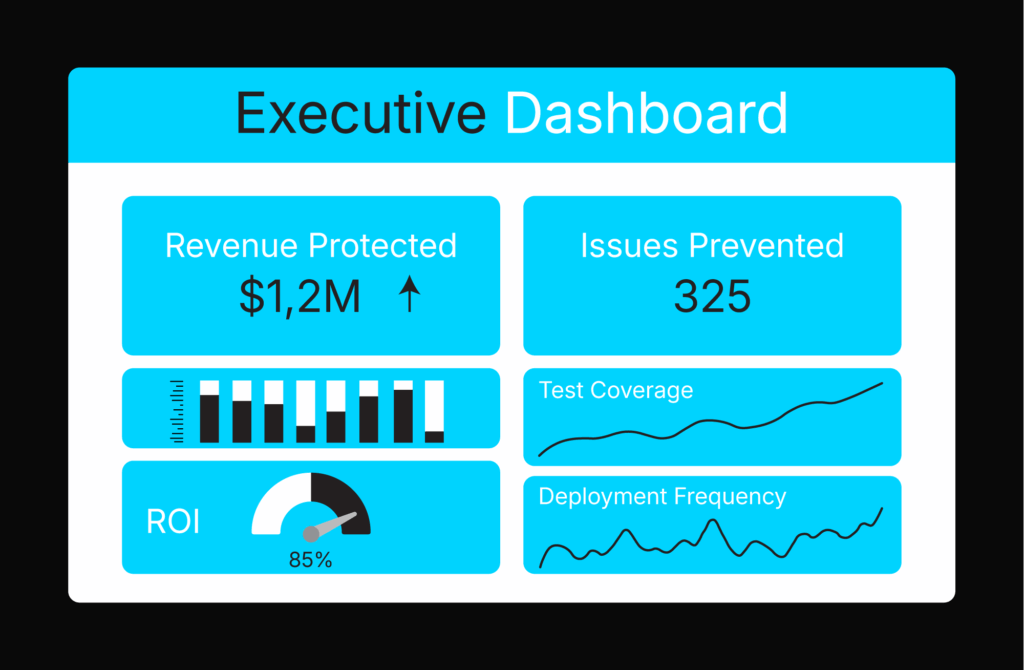
FAQs: The Questions Your Team Will Ask
“Do we need to rewrite all our existing tests?”
No. QA.tech complements existing test suites. Start with revenue-critical flows that aren’t well-covered by current tests.
“How does it handle our staging environment credentials?”
QA.tech operates entirely within your staging environment using credentials you provide. For payment providers, we support test mode APIs from Stripe, PayPal, and others.
“What about GDPR/security compliance?”
All test execution happens in isolated environments. No production data is used. We’re SOC 2 Type II certified and GDPR compliant.
“Can it handle our complex checkout flow?”
If a human can navigate it, our agent can test it. We’ve successfully tested flows with 15+ steps, multiple payment methods, and complex conditional logic.
“What’s the catch?”
The only “catch” is that you need to think differently about testing. Instead of maintaining scripts, you’ll be defining goals. Some teams find this transition challenging for about two weeks.
The Decision Point: Status Quo vs. Strategic Advantage
Every day you delay implementing autonomous QA, you’re accepting three costs:
- Direct revenue loss: $1,000-$5,000 daily in failed transactions
- Opportunity cost: Developers maintaining tests instead of building features
- Competitive disadvantage: Competitors who move first will capture your lost revenue
The question isn’t whether to adopt autonomous testing—it’s whether you’ll lead or follow.
Take Action: Your Revenue Deserves Protection
The path forward is clear:
Option 1: Free Revenue Risk Assessment
Book a 30-minute session where we’ll:
- Analyze your current checkout flows
- Calculate your specific revenue at risk
- Demonstrate autonomous testing on your actual site
- Provide a custom ROI projection
Schedule Your Risk Assessment →
Option 2: 14-Day Proof of Concept
Start protecting revenue immediately:
- Full platform access
- Dedicated implementation support
- Custom goal templates for your flows
- Daily executive reports on findings
Option 3: Technical Deep-Dive
For engineering teams wanting details:
- Architecture walkthrough
- API documentation review
- Integration planning session
- Q&A with our engineering team
The Bottom Line
In 2025, revenue protection isn’t about better testing—it’s about smarter testing. While your competitors wrestle with Selenium scripts and flaky tests, you could be using AI agents that understand your business goals and protect your revenue streams.
Thoughtworks has validated the approach. Industry leaders like Lavendla and SHOPLAB have proven the results. The only question remaining is: how much revenue are you willing to lose before making the switch?
QA.tech is the autonomous testing platform that protects revenue-critical flows for modern SaaS and e-commerce companies. Recognized by Thoughtworks Technology Radar as exemplifying the future of AI-powered testing, we help teams achieve 95%+ coverage of payment flows with zero maintenance overhead.

Stay in touch for developer articles, AI news, release notes, and behind-the-scenes stories.

